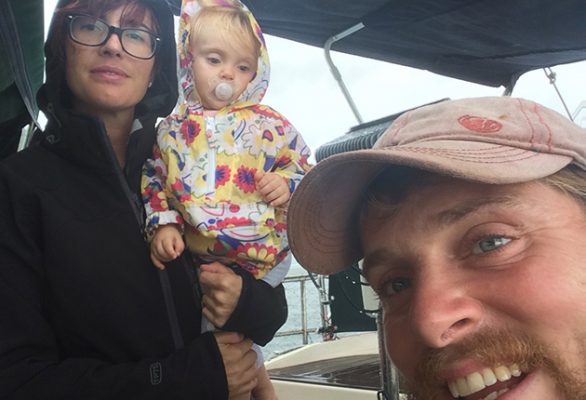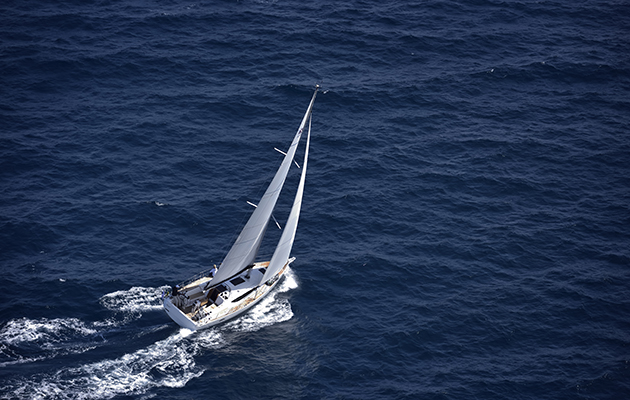Holly Turner shares some lessons from a turbulent hurricane season in the Caribbean with a 10-month-old baby and Scrumpy the Jack Russell
Learning curve: ‘The hurricane had us confined to the aft cabin for 24 hours’
After the challenge of an Atlantic Crossing there’s no better reward than to cruise the Eastern Caribbean. But what happens when the sailing season ends and the Atlantic hurricane season begins? writes Holly Turner
The Atlantic hurricane season runs from 1 June to 30 November.
For most cruisers it’s either haul out and tie down to return later in year, or head back to Europe via Bermuda and the Azores.

St George’s Anchorage, on our first night in Grenada. Credit: Holly Turner
However, that isn’t the case for everyone.
In 2017 my partner Simon and I, together with our 10-month-old daughter Daisy and Scrumpy the Jack Russell, decided to sail from Antigua to Grenada for our first hurricane season in the Lesser Antilles.
Little did we know it would also be the first year on record that the Leeward Islands are hit by not just one, but two category 5 hurricanes.
Many boats flock to Grenada to comply with their insurers’ terms and conditions.
At a latitude of 12˚N, the island is technically outside the hurricane belt. However, it still averages one hurricane every 50 years.
In May we started making our way slowly from Antigua. Keeping a close eye on the weather was imperative to our safety, allowing us to evaluate our short-term passage plans.
Preparing for Brett
Tudor Rose, our 37ft Colvic Countess, was tied to a mooring buoy in Marigot Bay, Saint Lucia, when Tropical Storm Brett was forecast to pass between Saint Lucia and St Vincent and the Grenadines.
Monitoring its projected route and strength as it established itself was unnerving and put our decision-making abilities to the test.

Simon, daughter Daisy, and first mate at the helm. Credit: Holly Turner
With sustained winds expected at 40 knots I wasn’t overly worried as we’d experienced 60-knot winds in Portugal, but this had been in a walled marina so there were still some concerns whether a berth alongside in Rodney Bay might be a safer option.
We spoke with fisherman and other seasoned cruisers, and concluded it was safe to stay on the mooring.
In the end the track changed and the storm made landfall at Trinidad, 200 miles away.
But planning for it did provide us with a good dry run.
It was now apparent we’d need the most up-to-date weather reports when confined to the boat, so we purchased a data package on a local SIM card.
Hit by Don
Another valuable lesson came in the form of Storm Don, whilst at anchor in Bequia, St Vincent and the Grenadines.
The National Oceanic and Atmospheric Administration (NOAA) issued a warning, forecasting a night of 40-50 knot winds.
We were happy to ride this one out, but my nerves were definitely on edge being at anchor.

Anchored in Admiralty Bay in Bequia, Holly and Simon changed to a heavier 25kg anchor for hurricane season. Credit: Holly Turner
We put a watch rotation in place, stowed away loose items and cleared the cockpit to allow quick and easy access to the helm if required.
The storm was short-lived, with sustained 40-knot winds only lasting 1 hour, but we dragged 30m, despite ensuring the anchor was well set.
It wasn’t a very comforting experience.
Fortunately we’d allowed plenty of space between us and other boats so we didn’t hit anyone.
After this close call we quickly exchanged our 15kg Bruce anchor for a 25kg CQR!
Holed up by Hurricane Harvey
Next, Hurricane Harvey hit the Caribbean as a Tropical Storm reformed into a hurricane and made landfall at Texas, USA.
Although most of the strong winds occurred away from the islands, sea conditions in our bay rapidly changed.
Normally protected from the East Trades, the bay was rough due to westerly swells.

Holly and Simon made their way down the Caribbean chain. Credit: Maxine Heath
Strong seas and breaking waves drove boats towards the shore. Docks were destroyed and boats violently bounced and jerked against their anchor chains.
In search of comfort and safety for Daisy we were confined to our aft cabin for almost 24 hours.
It was frustrating but we knew it wouldn’t last forever; you just learn to get on and deal with it.
Continues below…
How to sail across the Atlantic and back
Confined to quarters during the pandemic, many sailors are itching to slip their lines and sail for the sun. Elaine…
Offshore sailing skills: All you need to know
Will Bruton finds out what coastal cruisers should consider before taking their small yacht on an offshore adventure
Storm sailing: ‘The boat was slammed over and water poured in’
Randall Reeves leaves the storm jib in its bag while braving the Southern Ocean to prove that speed is safety…
Vendee Globe: Pete Goss on Escoffier’s rescue
When Kevin Escoffier’s boat sank in the Southern Ocean within two minutes, he was rescued by fellow Vendée Globe competitor…
Luckily Daisy coped really well and we kept her occupied with snacks, books, and watching Disney films.
We soon developed a strategy; for a low category hurricane (64-85 knot winds) we’d proceed to a hurricane hole, put out a stern anchor and drive the bow in to the mangroves.
If – Heaven forbid – a major hurricane of over 100-knot winds was coming our way, Simon would sail the boat by himself out of its path, most probably south to Trinidad, while Daisy and I sought shelter on land.
Party time in Grenada
We reached Grenada on 29 August, a little later than expected.
Anchorages were full of liveaboards seeking refuge and it was a challenge to find a suitable holding with adequate space between other boats.
Sometimes the swells made the bays roly and uncomfortable.

Cruisers converge on Prickly Bay in Grenada every year for hurricane season. There is a great community fell and lots of mutual support. Credit: Holly Turner
What really made this place special, though, was the overwhelmingly friendly and supportive sailing community.
Seafaring folk don’t tend to hang around in one location for long, so having hordes of them congregating annually has made Grenada quite the social scene during hurricane season!
Weekly events included yoga, dominoes, poker, a ladies’ lunch and live music.
Local drivers put on ‘shopping buses’ and if you need out-of-hours assistance you can call on the cruisers’ VHF hailing channel.

Grenada’s community spirit forged new friendships. Credit: Holly Turner
An interactive Cruisers’ Net also takes place six days a week on VHF.
The community spirit provided us with some much-needed stability throughout a very turbulent period, and we made so many friends.
It truly was an amazing two months in our adventure.
Hurricane Irma wrecks havoc
Unfortunately whilst all this was taking place a mammoth cyclone of devastation was about to tear its way through the Leeward Islands.
Irma was the strongest storm ever to form within the Atlantic before hitting the Caribbean.
It intensified from a tropical depression to a hurricane within 30 hours and then into a major hurricane two days later.
Reaching maximum winds of 155 knots, Irma first hit Barbuda 300 miles north of Grenada, followed by three more Caribbean islands, destroying almost everything in its path.

St Martin in the aftermath of Hurricane Irma in 2017. Credit: Getty
Then two weeks later another category 5, Maria, turned out to be the costliest on record, hitting Dominica and Puerto Rico and causing a catastrophic loss of lives.
Well away from both tracks, we were safe, but hearing of the aftermath through friends and social media was heart-wrenching.
On our Caribbean Facebook groups we saw submerged monohulls, upturned catamarans, and rows of charter yachts secured in the mangroves turned into piles of scrap.
People lost their homes and were left with no water, electricity or food.
Many did what they could to help, donating provisions, equipment and tools, and when the season finally came to an end, we all breathed a huge sigh of relief.
Lessons Learned
- Develop a strategy: Have a detailed action plan for securing the boat and put it into practice before the season starts to ensure it works.
- Get reliable forecasts and keep checking them: Check hurricane forecasts at least twice a day and six-hourly if there is anything developing. Use more than one source and make sure they are up to date.
- Access all areas: Ensure you have a dependable means of accessing weather forecasts from the boat, whether at sea or close to shore.
- Refine your anchoring technique and equipment: It’s not just about having the right equipment but also using it effectively. Any weak link in the process and your system is going to fail.
- Watch rotations: Lets face it, you’re not likely to sleep through a hurricane but having someone on watch is essential to quickly respond to any issues or raise the alarm.
- Be prepared before the hurricane hits: Activities are difficult to undertake during storm conditions. Prepare early, even if only on the outskirts of a storm.
- Have basic disaster supplies on hand : Keep water topped-up and have plenty of non-perishable food. Consider additional requirements for pets and children.
- Be ready to leave at a moment’s notice: As soon as you’re issued with a Hurricane Watch or Warning, ensure you’re prepped ready to set sail out of the threatened area.
Forecasts: A lifeline for cruisers
The National Oceanic and Atmospheric Administration (NOAA) hurricane centre monitors cyclones and disturbances in the Atlantic to predict if a depression will form into a storm.
As soon as one develops, it’s trailed by planes, analysed from space, examined from the ocean and penetrated by drones and ‘dropsondes’ (weather reconnaissance devices).
The data is put into models that predict the track and intensity of the storm, which can be days or weeks in advance of it progressing to a hurricane.
The National Hurricane Center website, run by NOAA, is a vital source of information to cruisers remaining in the Caribbean over hurricane season.
It’s updated every six hours and issues a tropical storm or hurricane ‘watch’ 48 hours in advance, changing to a ‘warning’ 36 hours in advance of tropical-storm-force conditions.
Enjoyed reading this article?
A subscription to Yachting Monthly magazine costs around 40% less than the cover price.
Print and digital editions are available through Magazines Direct – where you can also find the latest deals.
YM is packed with information to help you get the most from your time on the water.
- Take your seamanship to the next level with tips, advice and skills from our experts
- Impartial in-depth reviews of the latest yachts and equipment
- Cruising guides to help you reach those dream destinations
Follow us on Facebook, Twitter and Instagram.









